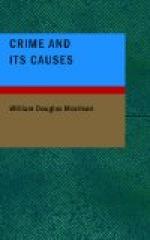[14] Physique Sociale, ii. 282.
[15] Zeitschrift fuer Strafrechtswissenschaft, ii., 486.
In testing these opinions respecting the influence of climate upon crime, we are obliged, to some extent, to have recourse to international statistics. But these statistics, as has already been pointed out, owing to the diversity of customs, laws, criminal procedure, and so on, do not easily admit of comparison. So much is this the case that we shall not make the attempt as far as these statistics have reference to crimes against property. In this field no satisfactory result can, at present be obtained. The same remark holds good in relation to all offences against the person, with the exception of homicide. This, undoubtedly, in an important exception; and it arises from the fact that there is a greater consensus of opinion among civilised communities respecting the gravity of homicide than exists with regard to any other form of crime. Murder in all its degrees is a crime which immediately causes a profound commotion; it is easy to recognise; it is more likely than any other offence to come to the ears of the authorities. For these reasons this crime lends itself most readily to international comparison; nevertheless, differences of judicial procedure, legal nomenclature, and different methods of classification stand in the way of making the comparison absolutely accurate. These differences, however, are not so great as to render comparison impossible or worthless; on the contrary, the results of such a comparison are of exceptional value, and go a long way to determine the question of the effect of climate upon crimes of blood.
Assuming, then, with these reservations, that such a comparison can be instituted, let us see to what extent murder, in the widest sense of the word, including wilful murder, manslaughter, and infanticide, prevails in the various countries of Europe. In ordinary circumstances this task would be a laborious one, entailing a minute and careful examination of the criminal statistics and procedure of many nations. Fortunately, it has recently been accomplished by Dr. Bosco in an admirable monograph communicated in the first instance to the Journal of the International Statistical Institute, but now published in a separate form. Bosco’s figures have all been taken from official sources, and may, therefore, be accepted as accurate; but, before tabulating-them, it may be




